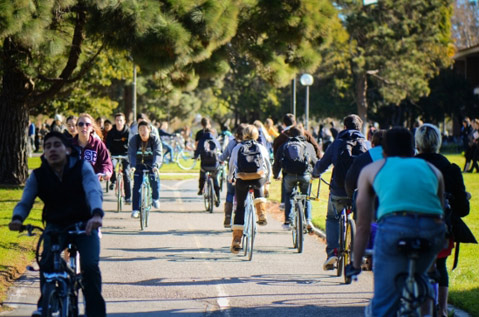
Density in Santa Barbara is increasing, with the addition of possibly more than 800 units under the Average Unit-Size Density program and with the easing of the permitting process for “granny units.” These changes create an opportunity for improving the walkability and bicycle friendliness of our town. The S.B. Bicycle Coalition has worked with our city and county governments to develop a bicycle master plan, which is adding more bike paths, improving the interconnectivity of bikeways, and physically separating more bike lanes from car lanes. Working cooperatively with local governments has enabled the coalition to leverage every dollar it raises into a hundred dollars’ worth of improvements.
Cycling raises concerns about safety, but a clear correlation exists between high cycling rates, more cycling infrastructure, and reduced risk of fatalities. Cities that invest in bicycling infrastructure get a big return on their investment.
Many European cities have embraced this for years. As Christopher F. Schuetze of the New York Times reported in September, Utrecht, Netherlands, population 330,000, has become one of the most bike-friendly places in the world. The city is just completing a three-story, state-of-the-art bike parking garage next to its train station. When finished, it will have a capacity of 12,000 bicycles. Sensors on the racks link to marquees that give real-time information to riders, making it easier to find an open spot. Ramps allow inside cycling to any floor — a new first for bike parking. In addition, this structure has a bike repair service, air pumps, and a bike-share business. The best part: Bikes park for free, something that hasn’t been offered to cars in urban parking structures for years.
The physical activity one gets from cycling reduces risk of obesity, type 2 diabetes, coronary heart disease, and some types of cancers. Utrecht officials estimate their $55 million annual expenditure on bike infrastructure returns $300 million in socioeconomic benefits that include health-care savings, reduced air pollution, increased productivity, less traffic, and beautiful living.
Throughout the Netherlands, deadly bike accidents have decreased 21 percent over the last two decades, while daily ridership has grown 11 percent in just the last decade. It is widely acknowledged that as more people bike, biking gets safer.
Copenhagen is considered the most livable city in the world, in no small part because it is so bike friendly. It wasn’t always this way. After World War II, the city became polluted and congested with car traffic. It took concerted and persistent efforts by the public to slowly transform the city into what it is today. With comparable, if not greater, natural beauty, and with impressive biking infrastructure improvements in the works, Santa Barbara could rival Copenhagen or any other bike-friendly European city. Moreover, all these advancements pay big dividends in reducing greenhouse gas emissions. Cars are the biggest source of global-warming carbon in S.B. County.



